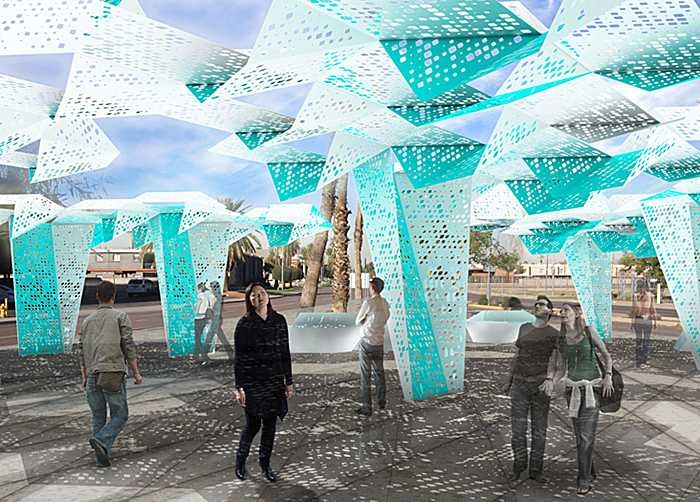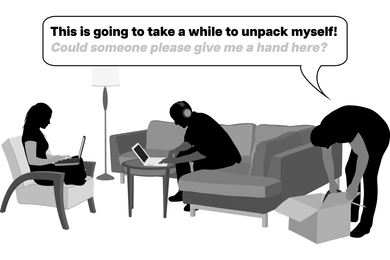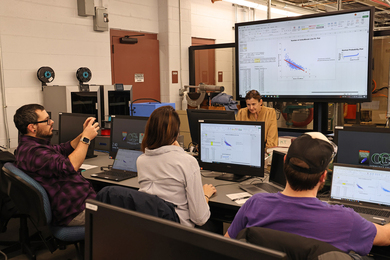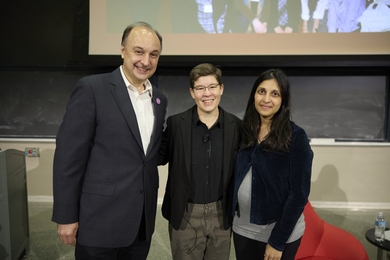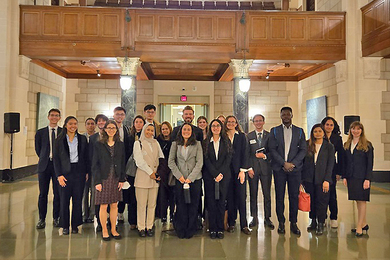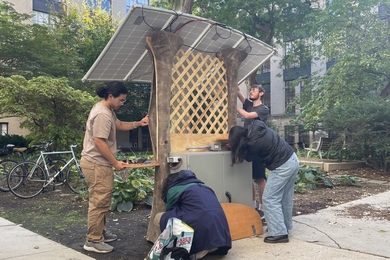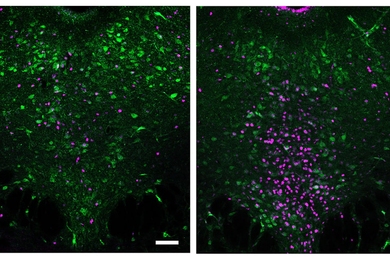This article originally appeared in the Spring 2013 issue of Spectrvm.
J. Meejin Yoon, an award-winning artist, architect and designer, is best known for creating large-scale, public art installations — including “White Noise/White Light,” which was featured at the 2004 Athens Olympics and later at MIT’s inaugural festivities for President Susan Hockfield.
She is also an associate professor of architecture at MIT and the co-founder of Höweler + Yoon Architecture. In 2005, she won the prestigious Rome Prize for design, an award that thrusts architects and artists onto the world stage. Recently her firm completed a 60,000-square-foot exhibition hall in Chengdu, China, earning the 2011 Annual Design Review Award for cultural buildings from Architect magazine.
“I love architecture because it forces a level of creativity within constraints, and I love doing public art installations because you can make your own constraints,” she says.
In her public installation work, Yoon uses sound and light to transform public areas. “Light Drift,” for example, draws visitors to the waterfront with an array of glowing orbs. Created for the city of Philadelphia, “Light Drift” was featured at MIT’s 150th anniversary Festival of Art, Science, and Technology (FAST), which Yoon curated. The piece invites visitors to sit on orbs arrayed onshore and discover that their actions create patterns of light on a river through wireless communication with a matrix of floating orbs.
The piece is a technological feat, but Yoon’s primary interest is not technology. “A lot of interactive art plays up the role of technology,” she notes. “However, my interest is in defamiliarizing contexts to create spaces of wonder and new forms of public interaction around them.”
In fact, Yoon had no background in computer-aided fabrication or interactive technologies when she began teaching at MIT in 2001. To become more comfortable, she took an MIT class How to Make (Almost) Anything, which proved transformative — introducing her both to the technologies she uses today and to many of the collaborators who help her develop her installations. That’s one of the reasons MIT is an ideal place to work in design, she says. “MIT is a special place, because here people still make things…Design is tied to the physical world.”
And the physical world presents its own challenges. Yoon had to wait three weeks for the wind speeds to pick up to power “Wind Screen,” an installation of 400 wind-powered LED lanterns that she hung on MIT’s Green Building for FAST. “[But] then the wind went crazy and it was perfect,” Yoon says. The wind spun each of the microturbine lanterns, and the result was a shimmering curtain of light.“That’s what inspires me to keep doing it.”
Yoon developed her first light and sound installation for the Athens Olympics after winning an international design competition. “I thought it would be interesting to capture the ephemeral movement of people through a field in this ancient city — to introduce a temporary unfamiliar landscape in a timeless one,” she says. She created a responsive field of thin fiber optics that lit up and emitted sound when people passed by, and “imagined it to be very serene.”
The reality was quite different — “White Noise/White Light” drew huge crowds and was occupied 24 hours a day. But Yoon discovered she loved watching people interact with the piece trying to guess how it worked. “That’s the whole point of my interactive installations. They should get people to talk and interact with each other,” she says. “It’s about creating an experience.”
J. Meejin Yoon, an award-winning artist, architect and designer, is best known for creating large-scale, public art installations — including “White Noise/White Light,” which was featured at the 2004 Athens Olympics and later at MIT’s inaugural festivities for President Susan Hockfield.
She is also an associate professor of architecture at MIT and the co-founder of Höweler + Yoon Architecture. In 2005, she won the prestigious Rome Prize for design, an award that thrusts architects and artists onto the world stage. Recently her firm completed a 60,000-square-foot exhibition hall in Chengdu, China, earning the 2011 Annual Design Review Award for cultural buildings from Architect magazine.
“I love architecture because it forces a level of creativity within constraints, and I love doing public art installations because you can make your own constraints,” she says.
In her public installation work, Yoon uses sound and light to transform public areas. “Light Drift,” for example, draws visitors to the waterfront with an array of glowing orbs. Created for the city of Philadelphia, “Light Drift” was featured at MIT’s 150th anniversary Festival of Art, Science, and Technology (FAST), which Yoon curated. The piece invites visitors to sit on orbs arrayed onshore and discover that their actions create patterns of light on a river through wireless communication with a matrix of floating orbs.
The piece is a technological feat, but Yoon’s primary interest is not technology. “A lot of interactive art plays up the role of technology,” she notes. “However, my interest is in defamiliarizing contexts to create spaces of wonder and new forms of public interaction around them.”
In fact, Yoon had no background in computer-aided fabrication or interactive technologies when she began teaching at MIT in 2001. To become more comfortable, she took an MIT class How to Make (Almost) Anything, which proved transformative — introducing her both to the technologies she uses today and to many of the collaborators who help her develop her installations. That’s one of the reasons MIT is an ideal place to work in design, she says. “MIT is a special place, because here people still make things…Design is tied to the physical world.”
And the physical world presents its own challenges. Yoon had to wait three weeks for the wind speeds to pick up to power “Wind Screen,” an installation of 400 wind-powered LED lanterns that she hung on MIT’s Green Building for FAST. “[But] then the wind went crazy and it was perfect,” Yoon says. The wind spun each of the microturbine lanterns, and the result was a shimmering curtain of light.“That’s what inspires me to keep doing it.”
Yoon developed her first light and sound installation for the Athens Olympics after winning an international design competition. “I thought it would be interesting to capture the ephemeral movement of people through a field in this ancient city — to introduce a temporary unfamiliar landscape in a timeless one,” she says. She created a responsive field of thin fiber optics that lit up and emitted sound when people passed by, and “imagined it to be very serene.”
The reality was quite different — “White Noise/White Light” drew huge crowds and was occupied 24 hours a day. But Yoon discovered she loved watching people interact with the piece trying to guess how it worked. “That’s the whole point of my interactive installations. They should get people to talk and interact with each other,” she says. “It’s about creating an experience.”
